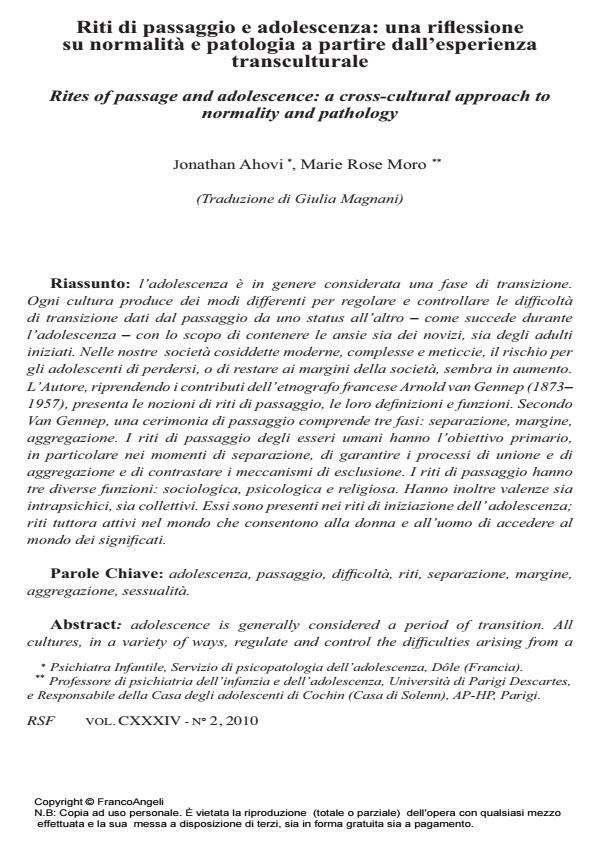Riti di passaggio e adolescenza: una riflessione su normalità e patologia a partire dall’esperienza transculturale
Titolo Rivista RIVISTA SPERIMENTALE DI FRENIATRIA
Autori/Curatori Jonathan Ahovi, Marie Rose Moro
Anno di pubblicazione 2010 Fascicolo 2010/2
Lingua Italiano Numero pagine 12 P. 23-34 Dimensione file 318 KB
DOI 10.3280/RSF2010-002003
Il DOI è il codice a barre della proprietà intellettuale: per saperne di più
clicca qui
Qui sotto puoi vedere in anteprima la prima pagina di questo articolo.
Se questo articolo ti interessa, lo puoi acquistare (e scaricare in formato pdf) seguendo le facili indicazioni per acquistare il download credit. Acquista Download Credits per scaricare questo Articolo in formato PDF

FrancoAngeli è membro della Publishers International Linking Association, Inc (PILA)associazione indipendente e non profit per facilitare (attraverso i servizi tecnologici implementati da CrossRef.org) l’accesso degli studiosi ai contenuti digitali nelle pubblicazioni professionali e scientifiche
L'adolescenza è in genere considerata una fase di transizione. Ogni cultura produce dei modi differenti per regolare e controllare le difficoltà di transizione dati dal passaggio da uno status all’altro - come succede durante l’adolescenza - con lo scopo di contenere le ansie sia dei novizi, sia degli adulti iniziati. Nelle nostre società cosiddette moderne, complesse e meticcie, il rischio per gli adolescenti di perdersi, o di restare ai margini della società, sembra in aumento. L’Autore, riprendendo i contributi dell’etnografo francese Arnold van Gennep (1873 - 1957), presenta le nozioni di riti di passaggio, le loro definizioni e funzioni. Secondo Van Gennep, una cerimonia di passaggio comprende tre fasi: separazione, margine, aggregazione. I riti di passaggio degli esseri umani hanno l’obiettivo primario, in particolare nei momenti di separazione, di garantire i processi di unione e di aggregazione e di contrastare i meccanismi di esclusione. I riti di passaggio hanno tre diverse funzioni: sociologica, psicologica e religiosa. Hanno inoltre valenze sia intrapsichici, sia collettivi. Essi sono presenti nei riti di iniziazione dell’ adolescenza; riti tuttora attivi nel mondo che consentono alla donna e all’uomo di accedere al mondo dei significati.
Parole chiave:Adolescenza, passaggio, diffilcoltà, riti, separazione, margine, aggregazione, sessualità.
Jonathan Ahovi, Marie Rose Moro, Riti di passaggio e adolescenza: una riflessione su normalità e patologia a partire dall’esperienza transculturale in "RIVISTA SPERIMENTALE DI FRENIATRIA" 2/2010, pp 23-34, DOI: 10.3280/RSF2010-002003